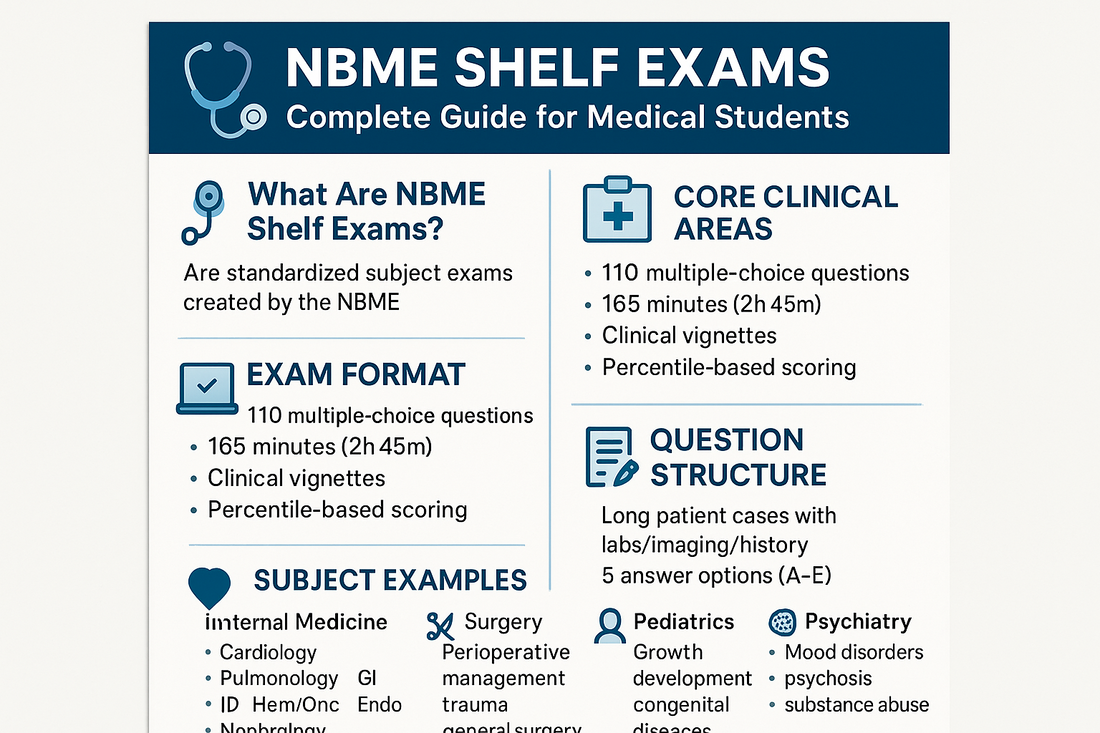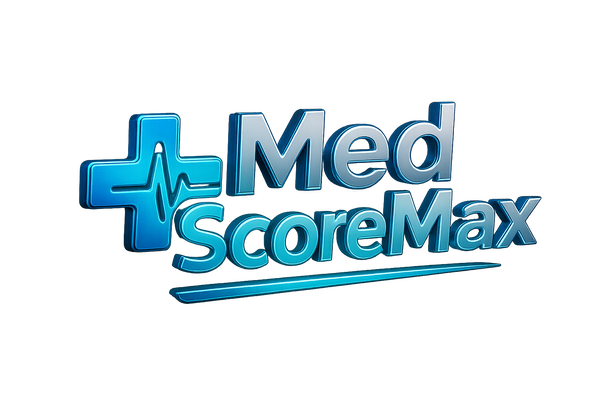
NBME Shelf Exams Explained: Format, Scoring & Tips
Share
The NBME Shelf Exams are some of the most important tests you’ll face during medical school. Whether you’re in your third year starting clinical rotations or preparing for residency applications, the shelves determine a large part of your clerkship grade. This guide will cover everything you need to know about the NBME Shelf Exam format, scoring, and preparation tips—along with free resources, practice PDFs, and strategies from top scorers.
📌 What Are NBME Shelf Exams?
The NBME Shelf Exams are standardized subject exams created by the National Board of Medical Examiners (NBME). They assess your knowledge in the core clinical clerkship areas:
-
Internal Medicine
-
Surgery
-
Pediatrics
-
Obstetrics & Gynecology (OB/GYN)
-
Psychiatry
-
Family Medicine
-
Neurology (offered by some schools)
👉 These exams are often taken at the end of each clinical clerkship rotation, usually lasting 6–12 weeks.
💡 Important: Shelf exams are NOT required for Step 1 or Step 2 CK, but they’re designed to test the same clinical reasoning skills—and they prepare you directly for Step 2 CK.
📘 NBME Shelf Exam Format
Each exam is computer-based and proctored by your medical school. While small details may vary by institution, the general format includes:
-
Length: 110 multiple-choice questions
-
Time: 165 minutes (2 hours, 45 minutes)
-
Question Type: Clinical vignettes (similar to USMLE-style questions)
-
Scoring: Percentile-based compared against national performance
Example Question Breakdown
-
A long patient case with labs, imaging, and history
-
5 answer options (A–E)
-
Single best answer
Subjects Tested
Each shelf exam covers the “core” of its specialty. For example:
-
Internal Medicine: Cardiology, Pulmonology, Gastroenterology, Infectious Disease, Hematology/Oncology, Endocrinology, Nephrology.
-
Surgery: Perioperative management, trauma, general surgery, surgical complications.
-
Pediatrics: Growth, development, congenital diseases, infectious pediatrics.
-
Psychiatry: Mood disorders, psychosis, substance abuse, emergency psychiatry.
👉 Many NBME practice exams mirror the Step 2 CK format, so preparing for shelves doubles as Step 2 prep.
📊 NBME Shelf Exam Scoring Explained
Unlike Step exams (which are now pass/fail for Step 1), shelf exams are scored relative to national performance.
-
Raw Score → Percentile Conversion: Your number of correct answers is compared to a reference group of students nationally.
-
School Grading: Each med school sets its own cutoff for “Honors,” “High Pass,” or “Pass.” Example:
-
Honors: ≥ 85th percentile
-
High Pass: 60–84th percentile
-
Pass: ≥ 10th percentile
-
Fail: < 10th percentile
-
⚡ Key Note: Scores are NOT curved at your school level; they are standardized against all test-takers.
🔑 NBME Shelf Exam Tips from Top Scorers
1. Start Studying from Day 1 of Your Rotation
Don’t wait until the last two weeks. Integrate UWorld QBank and NBME practice exams alongside your clinical learning.
2. Use Case-Based Learning
Shelf exams test reasoning, not memorization. Use resources like:
-
UWorld Step 2 CK (gold standard)
-
AMBOSS QBank
-
OnlineMedEd (OME) videos for quick refreshers
-
Anki Decks (Zanki, Lightyear, Dorian) for spaced repetition
3. Take NBME Practice Exams
NBME offers subject-specific self-assessments ($20 each). While expensive, they’re the closest predictor of your shelf score.
🔗 Try to take at least one practice exam 1–2 weeks before test day.
4. Focus on High-Yield Topics
For each subject:
-
Internal Medicine Shelf: ECGs, antibiotics, heart failure, diabetes, pneumonia, renal disease.
-
Surgery Shelf: Trauma protocols (ABCDE), post-op complications, surgical infections.
-
Psychiatry Shelf: Depression, schizophrenia, bipolar disorder, substance use, suicide risk.
5. Build Test Stamina
Shelf exams are long. Practice timed blocks to simulate the real thing.
📂 Free NBME Shelf Exam PDFs & Study Plans
We’ve created free downloadable PDFs to help you streamline prep:
-
📑 Surgery Shelf High-Yield Mnemonics (PDF)
-
📑 Psychiatry Shelf Quick Reference Guide (PDF)
-
📑 Question Bank Compilation from past exams
👉 Premium Access: Get full access to recalls, past papers, and best study materials here:
🔗 Exclusive Access to All Exams & Resources
🔐 How to Check NBME Shelf Exam Scores
Your score report is usually available through your NBME login portal or directly via your medical school’s registrar.
-
Log in at NBME.org
-
Navigate to “MyNBME Services”
-
Select “Exam Results” → Shelf Exam
-
Download PDF score report
🌍 NBME Shelf Exam Community (Reddit & Beyond)
-
NBME Subject Exams Reddit: Great for exam recall threads, test-taking strategies, and resource recommendations.
-
Med School Discords & Slack Groups: Peer support and study accountability.
-
NBME Practice Exams Free: Sometimes found shared by students, though official NBME forms are the most reliable.
📌 Internal Links for Further Study
❓ FAQs on NBME Shelf Exams
1. How hard are NBME shelf exams?
They’re challenging, especially since they’re taken during busy clinical rotations. They require both broad knowledgeand fast clinical reasoning.
2. How do I prepare for NBME Internal Medicine Shelf?
Focus on UWorld Step 2 CK QBank, AMBOSS, and practice with NBME IM self-assessments. Internal Medicine is the broadest shelf—start early.
3. Are NBME practice exams accurate predictors?
Yes. Most students report NBME practice scores are within ±5 points of their real shelf exam.
4. Can I retake a shelf exam if I fail?
Policies vary by school, but typically yes—you’ll be required to remediate and retake.
5. Where can I find NBME Shelf Exam PDFs?
You can access our free PDFs above or unlock premium recalls and practice exams here:
👉 Get Access to All Shelf Exam Materials
✅ Bottom Line:
The NBME Shelf Exams test application of knowledge, not just memorization. With the right mix of UWorld, NBME practice tests, and high-yield PDFs, you can crush your shelves—and set yourself up for Step 2 CK success.
